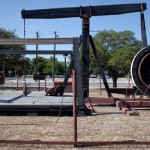Does the Keystone Pipeline Delay Actually Hurt Green Energy?

Karen Bleier/AFP/Getty Images
Demonstrators protest the Keystone XL pipeline in front of the White House on November 6, 2011
Environmental groups that have opposed the Keystone XL pipeline won something of a victory yesterday, when the Obama administration announced that it would delay a decision on the project.
But that announcement raised more questions than it answered. Will the pipeline’s delay ultimately kill the project altogether? Will other sections of the pipeline (like the Oklahoma-to-Gulf Coast section) be able to go forward separately? Will another company, like Enbridge, pick up where TransCanada left off, but build a pipeline that bypasses the U.S. altogether?
Add to that list a new question: Is the pipeline delay actually a setback for green energy?:
In an op-ed in today’s New York Times, Michael Levi, a senior fellow for energy at the Council on Foreign Relations, argues that yesterday’s victory for environmentalists might be a scenario where they’ve shot themselves in the green foot.
Levi argues that the push against Keystone XL exemplified a tried and true tactic of environmental groups. “The shortest route to blocking fossil fuel development appears to be leveraging local opposition.” But by appealing to NIMBY-ist opposition to oil and gas projects, they run the risk of encouraging similar efforts to stop green energy development:
We’re already seeing some of this conflict between the ambitions of environmentalists and green energy in Texas, where the Sierra Club is opposing potential offshore wind farms. Their concern? Birds. The group is worried that birds on the Padre Island seashore will be injured or killed by the rotating blades of some 200 proposed offshore wind turbines. But the Sierra Club has commended the company behind the project for agreeing to an environmental impact study, even though one isn’t required.“The country has already seen strong opposition to offshore wind energy in Massachusetts, including from environmental activists and local landowners, on the grounds that it will ruin spectacular ocean views. Solar plants will need to be built in sunny deserts, but local opponents continue to insist that the landscape blight would be intolerable. New long distance transmission lines will have to cross multiple states in order to bring that power to the places that need it most. Once again, though, a patchwork of local concerns and inconsistent state regulation is already making the task exceedingly difficult.
And those may be the easy cases. Zero-carbon nuclear power will ultimately require depositories for radioactive waste, but if the intense (and ultimately successful) backlash against the Yucca Mountain facility in Nevada is any indication, local pushback is pretty much inevitable. If technologies that capture greenhouse gas emissions from coal-fired power plants can be successfully deployed, they’ll still need somewhere to store the carbon dioxide underground. Few people are likely to be enthusiastic about that happening in their backyards.”
And over the past few years a huge wind power transmission line project faced vocal opposition from locals, who worried that the 180-foot tall towers would hurt property values and ruin scenic hill country views. The project ultimately passed, and the lines are now under construction.
So will green energy and environmental groups be able to have it both ways? “They will find themselves increasingly appealing to the federal government for help in overriding local opposition to wind farms, solar plants, long distance transmission lines and other critical pieces of zero-carbon infrastructure,” Levi writes. “These two endeavors will conflict.”


